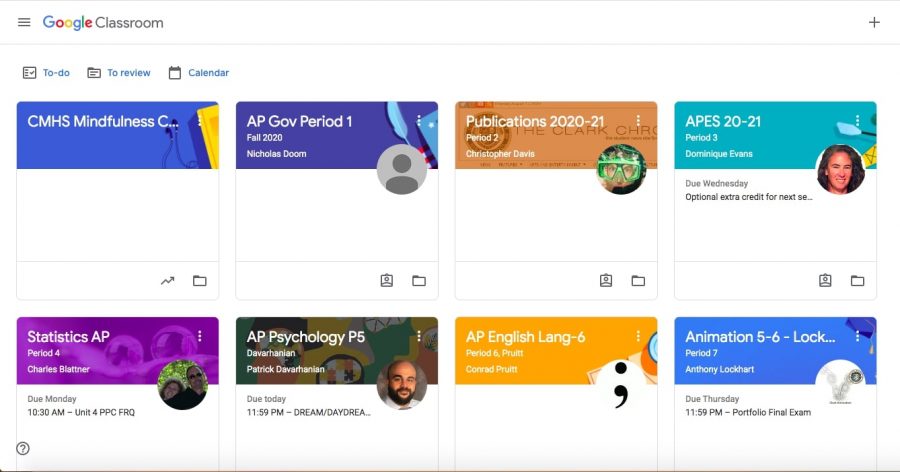Remote learning from the perspective of teachers
Teachers confront their overcome their own set of academic obstacles for students to excel while learning at home
December 7, 2020
Google Classroom is one of the most used online learning platforms being used during the COVID-19 pandemic.
“I was simultaneously saddened and relieved at the same time,” says United States history and Psychology teacher Patrick Davarhanian in regards to learning that schools would close in spring of 2020. “The first thing that came to my head was prom. I was concerned my seniors would not get to experience this important coming-of-age event, but at the same time I was also relieved knowing that our district and the community had embraced science and that we were determined to continue educating our students responsibly.”
When the COVID-19 pandemic reached the United States, daily life for civilians was completely altered. For students and teachers, academic instruction was forced to transition into a remote model as schools across the nation were among the facilities closed. According to the United States Census Bureau, 93 percent of American households have reported some form of remote learning for school-age children during the novel coronavirus pandemic.
Academically, teachers were tasked with redesigning their lesson plans to fit the limitations of the virtual world while at the same time keeping spirits high during the global crisis. In order to transition to a remote learning model, teachers depended on online resources that are accessible to all students from home. While some of these resources are also used in a conventional classroom setting, a heavier emphasis was placed on them during the pandemic. “I am using interactive Google Sheets assignments, Google Slides and Nearpod,” Davarhanian said. “Nearpod is an interactive site that allows students to answer questions, share opinions and discuss important topics while they watch informative videos or presentations.”
Instructors have also been indirectly given the responsibility of handling the social-emotional needs of students during the pandemic. “I think teachers are doing the best they can given the situation. We have participated in various professional development opportunities during summer break and are aware of our students’ social emotional needs,” Davarhanian said. “I am committed to helping my students succeed and I want to make sure they have all the tools they need. It is important that we all work together and understand each other. Empathy is essential.”
When schools closed in the spring, Spanish teacher and mock trial advisor Melissa O’Gara felt relieved to find out about the transition to remote learning. “I was grateful because I did not want to be put in a dangerous situation and I did not want my students to be put in that kind of situation either,” O’Gara said. “When we left on March 13, I kind of knew. The word had gone around. I had a sister-in-law in Santa Clarita that told me to get everything set up in Google Classroom three weeks before we [were out of school.] When she did it, I did it.”
For her classes, O’Gara learned to use resources to help students in learning a foreign language remotely and also participate in mock trial activities as authentically as possible. “[Students] recording their voices and me responding was huge. Having students watch a video they had done was huge,” O’Gara said. “I think having Google Slides, using things like that, collaborative work so students can still work together and communicate. There’s actually, I think, more writing involved simply because you can do that offline.”
However, given the limitations of the remote learning model, there are obstacles in terms of student monitoring that rise during video-conferencing. “The audio, I do in small groups in Zoom, which has helped a lot. The problem is that some students turn off their camera, turn off their audio, turn off their video as soon as they go into their small groups and the whole point of the lesson is gone. I really have to bounce in and out of groups to make sure they are on task,” O’Gara said.
Tech Lit and animation teacher Anthony Lockhart understands that students are still receiving a quality education, but acknowledges the challenges of the distance learning format. “I feel that I could teach my students way more in a face-to-face setting. Does that mean they are getting a bad education with distance learning? Not necessarily, but there are some issues with the lack of communication.” Lockhart recognizes that synchronous classes which are taught remotely have their limitations, despite the live instruction. “For instance, when you are teaching something in animation, I can say ‘This is how you draw something’ and look and see everybody’s screen and I immediately know ‘That did not work’ and I can modify the way I am teaching because I didn’t do it right,” Lockhart said. “That is gone with distance learning and part of the reality is that some students have four family members and they are on their own Zoom calls at the same time. It’s really hard to learn in an environment where you don’t have a quiet room. I would say that checking to see if someone understands [class material] is the hardest part.”
A major challenge of a distance learning format is the lack of classroom resources that would otherwise be accessible during an in-person form of instruction. “We are in a situation where we have a student body who has such tremendous access [to classroom resources], so they have a potential that is humungous, but even though the campus is closed, they still have a pretty amazing potential,” Lockhart said. “I still think it is possible to help them reach that potential but is it as good as it could have been? No. We’re talking every kid has a $2,000 tablet when [students go to school] but that isn’t the case right now. However, if you look at my ninth graders, they are doing full-on animation.”
